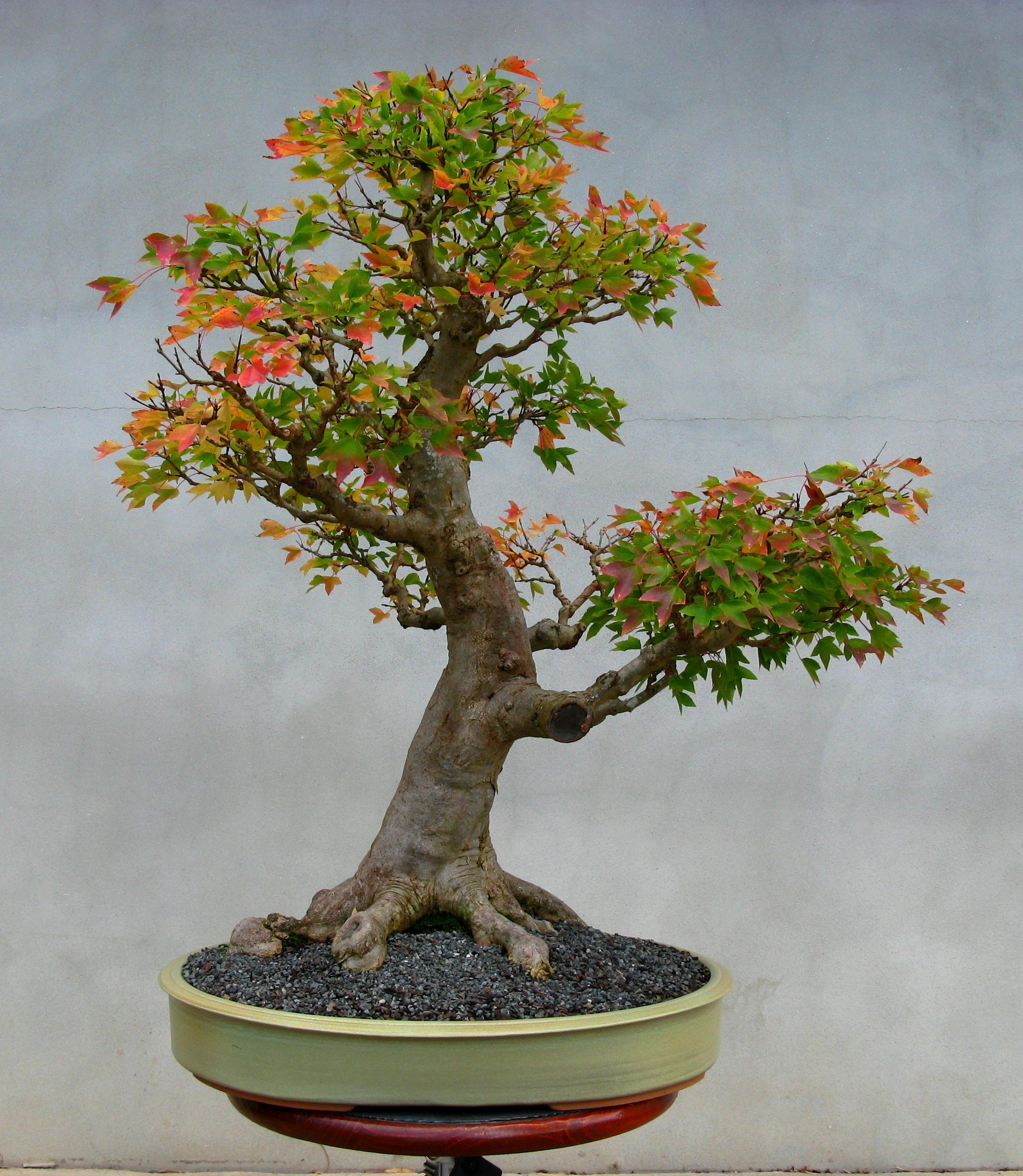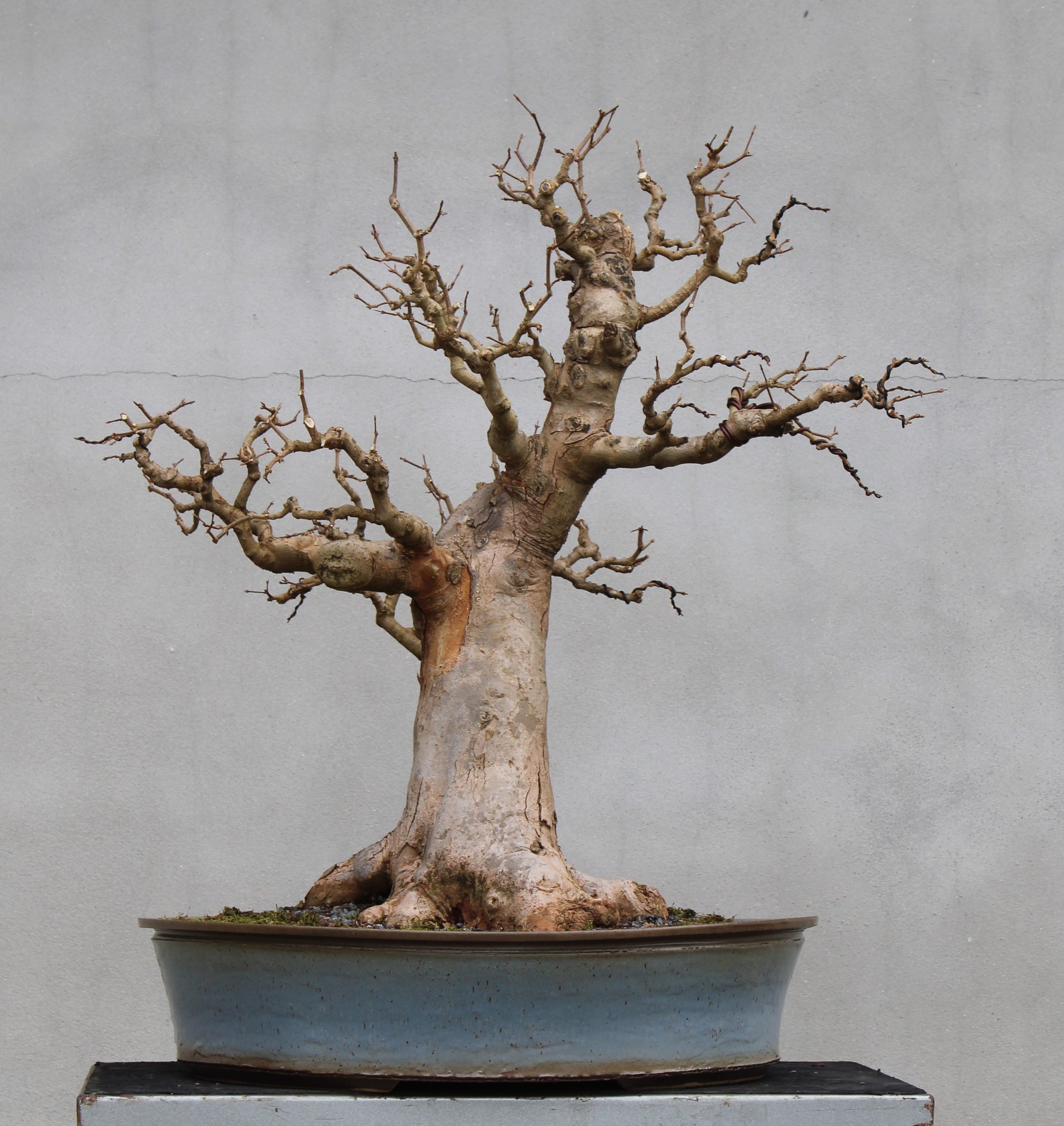Big Trident
This happened on the second trip to Butner, when we were gathering the donated bonsai to bring them back to Asheville. The pickup trucks were just about full and I was making one last check of the plant room to see if anything remained. There was a big pot made of redwood, the kind you might use for growing a tree out on a patio, and jutting up out of the soil in the pot was a piece of wood like an upside-down baseball bat. It was large and looked somewhat bonsai-like but it was just a trunk, no branches or foliage. Mr. Staples came along so I asked him if the trunk in a pot was supposed to go with us. “Yeah,” he said, “That goes.” I bent to pick it up. “Be careful with that,” he said, “I paid five hundred dollars for that stick!”
It turned out the trunk belonged to a big trident maple (Acer buergerianum). When we did the photo-documentation of the bonsai received in that first donation, we didn’t bother taking a picture of the expensive stick in a pot. There didn’t seem to be any good reason to do so. There is no photograph of it, but it’s easy enough to show you what it looked like:
Scratching on the bark of the trident trunk revealed healthy green tissue, so there was still life in it. There was plenty else to do with the other donated trees, the ones that came with branches, so the cutoff maple in the redwood tub was stuck aside in the hoop house and left to its own devices. When spring came, new shoots emerged from the trunk and it looked something like this:
The following year — 1994 — I decided to repot the big trident trunk with the sprouts now popping out all over it. When I did I found something curious. The girth of the trunk was impressive, but the base of the tree was one-sided. It had flare and good surface roots on one side but the other side was completely flat. I hadn’t learned much about bonsai yet, but I already knew it was desirable to have flare and surface roots all around the base of the tree and not just on one side. When I took the tree out of the tub and started working away at the medium, it was revealed that there actually were good surface roots all around the base, though half of them were buried. It was apparent that the last time the tree was potted someone had decided they wanted to make a formal upright bonsai. The trident had originally been leaning in its posture, but it was potted straight upright to achieve a desired look, and as a consequence half of the natural base of the tree wound up below the soil line.
When the tree was planted back into the pot, I returned it to its original slanting attitude and suddenly it had an impressive, flaring base, with sizable surface roots stretching out in all directions. At the same time, I shortened the trunk a bit and selected one of the young shoots to take over as the continuation of the trunk line. After that work session the big trident maple had this appearance:
It was around this time I learned about planting bonsai training trees in the ground as a way to accelerate trunk development. The big trident was a prime candidate for this treatment, and so it was one of the very first plants we handled in such a manner. The following image shows the tree at some point toward the end of its five- or six-year stint growing in the ground:
Early 2000s
The next available image shows the big trident out of the ground and back in a large training pot, with considerable work having been done to establish the general shape it would have as a bonsai:
2007
A photo from the following spring shows the increase of a year’s worth of branch ramification and the use of bamboo rods as spacers to push branches into a more horizontal position:
2008
The next series of images is from 2011. By this time the trident maple had developed to a level that called for a good pot, and by the end of the viewing season it had found its way out on display in the bonsai garden (click on any image for full view):
For the next seven years the big trident was out on display in the garden on a regular basis. The following gallery of images tracks the tree’s development and shows the seasonal interest that makes trident maple an appealing choice for bonsai use. Note that the container for the tree changed in 2014 due to damage sustained by the original pot from winter freezing. The replacement pot, although attractive and a suitable style for the trident, was not really large enough. However, it was the best option available at the time. Also take note of the large, round pruning scar on the lowest branch on the right side of the tree. In 2012 the callous material was just beginning to form around the periphery of the wound, and by 2015 the area was completely covered over (click on any image for full view):
The following image shows the big trident out on display in the garden in 2018, but by this time I was growing discontent with the look of it:
2018
It seemed to me the silhouette of the tree was out of balance, with too much mass on the left side or perhaps too little on the right. The apex was wrong, too. When originally designing this bonsai I gave it a single-line leader, which is how bonsai are customarily set up, but that look is completely inauthentic for a deciduous tree in nature. Mature deciduous trees almost always feature multiple branch lines combining in their effect to form a broadly rounded apex. The inaccuracy of the shape I had given this specimen became ever more bothersome to me as the years went by.
In November of 2018 I was invited to present an educational program for the Pittsburgh Bonsai Society, and I decided to restructure the big trident in a live demonstration. I had never visited with this particular group before and I’m not sure what the members thought of my program. I suspect at least some of them thought I ruined a perfectly good bonsai.
A great deal of pruning took place in the demonstration, resulting in a substantial reduction of the left side of the composition. The biggest change occurred in the top of the tree, where the single-line apex was removed and several lateral branches were repositioned to form a new multi-line apex. I chose to use guy wires to pull branches into new positions because I knew it would take a year or two to get the branches to set, and I didn’t want to risk accidentally scarring branches by wiring them in the usual manner. Here is what the tree looked like after the session in Pittsburgh:
2019
The next two images show what was done in the top of the tree. Note that the old top was not completely removed; a stump of it was left behind to serve as a handy place to anchor several guy wires pulling up nearby branches to form a new top. The result was not attractive in the short term, but the technique was employed for a long term purpose (click on either image for full view):
The view of the bonsai in this next image is a possible alternative to the way it is typically presented:
This view, looking down on the lowest and largest branch, shows the naturalistic branching structure and further illustrates the use of guy wires for repositioning:
In spring of 2023 the big trident was planted in new container made by Robert Wallace:
2023
Note that the stump of the old single-line apex was removed, as were the guy wires. The lateral branches that were repositioned in an upward posture to build a new apex had set in place:
Two alternate views of the tree (click on either image for full view):
After a four-year hiatus, the big trident is now back out on display in the bonsai garden. To my eye, the top of the tree needs to fill out a little more, and it will over time. Meanwhile it is not unpleasant to look at as it is:
This bonsai was literally nothing more than a stick in a pot to start with, but it’s come a long way since then. It shows the importance of starting with the right stick! (Click on any image for full view:)































